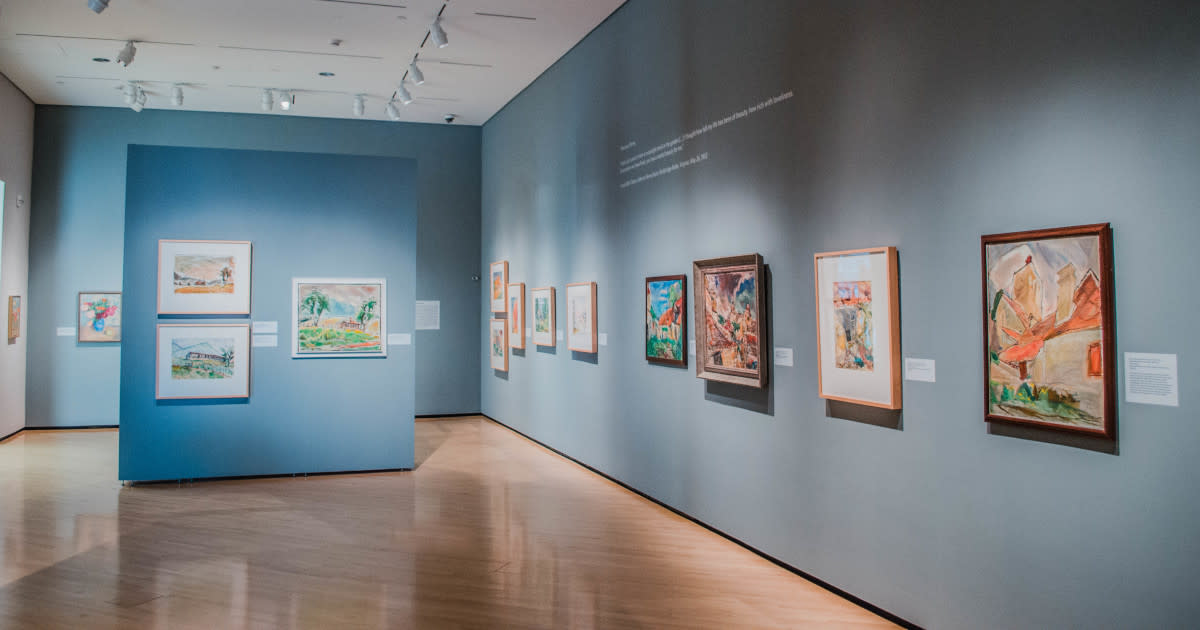Art Galleries: A Journey Through Creativity and Expression
6 min read
Art Galleries
Contents
Art Galleries has been an integral part of human expression for millennia, serving as a mirror to society, a catalyst for change, and a source of profound beauty. In the bustling landscape of the art world, one venue stands as a sanctuary for artistic appreciation and contemplation: the art gallery. Let’s delve into the enchanting realm of art galleries, where creativity thrives and stories unfold on canvases and sculptures.

The Art Gallery Experience: A Feast for the Senses
Stepping into an art gallery is akin to entering a portal to another dimension, where colors dance, shapes intertwine, and emotions stir. The gallery space is meticulously curated to enhance the viewer’s experience, with carefully arranged artworks adorning the walls or displayed on pedestals, inviting exploration and introspection.
Visual Delight:
From vibrant oil paintings to intricate mixed-media installations, art galleries offer a diverse array of visual stimuli that captivate and inspire. Each artwork is a window into the artist’s soul, conveying thoughts, emotions, and perspectives through strokes of a brush or sculpted forms.
Immersive Atmosphere:
The ambiance of an art gallery is often serene and contemplative, providing a sanctuary for reflection amidst the chaos of everyday life. Visitors are encouraged to lose themselves in the artworks, engaging in a silent dialogue with each piece and finding meaning in their unique interpretations.
Cultural Enrichment:
Art galleries serve as custodians of culture and heritage, preserving and showcasing artworks that reflect the richness and diversity of human experience. Whether featuring contemporary masterpieces or ancient artifacts, galleries offer glimpses into different epochs and civilizations, fostering cross-cultural understanding and appreciation.
The Role of Art Galleries in the Community
Art GalleriesBeyond serving as venues for aesthetic pleasure, art galleries play a vital role in enriching communities and fostering artistic growth and innovation.
Promoting Emerging Artists:
Many galleries are dedicated to showcasing the works of emerging and local artists, providing them with a platform to gain recognition and exposure. These spaces nurture creativity and experimentation, encouraging artists to push the boundaries of their craft and explore new avenues of expression.

Educational Outreach:
Art galleries often host educational programs, workshops, and lectures aimed at engaging audiences of all ages and backgrounds. These initiatives promote art appreciation, enhance visual literacy, and spark meaningful dialogues about social, political, and cultural issues.
Catalysts for Social Change:
Art has the power to provoke thought, challenge conventions, and ignite social movements. Galleries frequently exhibit works that confront pressing societal issues, such as inequality, environmental degradation, and human rights abuses, serving as catalysts for dialogue and advocacy.
In an increasingly digital age, art galleries are adapting to new trends and technologies while remaining steadfast in their commitment to preserving and promoting the arts.
Virtual Exhibitions:
With the advent of virtual reality and online platforms, art galleries are expanding their reach beyond physical spaces, offering virtual exhibitions that can be accessed from anywhere in the world. These digital galleries democratize access to art and enable artists to reach global audiences.
Art Market Innovations:
The art market is constantly evolving, with new business models and platforms emerging to connect artists, collectors, and enthusiasts. Online marketplaces, art fairs, and blockchain technology are reshaping the way art is bought, sold, and valued, ushering in a new era of accessibility and transparency.
Sustainability Initiatives:
In response to growing environmental concerns, many art galleries are embracing sustainability initiatives to minimize their ecological footprint. From eco-friendly exhibition materials to carbon-neutral practices, galleries are striving to create more environmentally conscious and socially responsible spaces.
Celebrating Creativity and Diversity in Art Galleries
Art galleries are more than mere repositories of artwork; they are vibrant hubs of creativity, innovation, and cultural exchange. As we navigate the complexities of the modern world, these jonitogel login sanctuaries of self-expression and imagination remind us of the transformative power of art to transcend boundaries, unite communities, and inspire positive change. So, whether you’re a seasoned art aficionado or a curious novice, step into an art gallery and embark on a journey of discovery, enlightenment, and boundless possibility.

Art galleries stand as bastions of creativity, offering a space where artists can showcase their work, and enthusiasts can immerse themselves in the beauty and complexity of artistic expression. However, like any institution, art galleries come with their own set of advantages and disadvantages. Let’s delve into the intricacies of these creative spaces to understand their impact on artists, audiences, and society as a whole.
Advantages of Art Galleries
- Exposure and Recognition: For artists, art galleries provide a platform to showcase their work to a wider audience, including collectors, curators, and critics. This exposure can lead to increased recognition, opportunities for collaboration, and potential sales of their artwork.
- Curation and Context: Art galleries curate exhibitions with care and intention, presenting artworks in a context that enhances their meaning and significance. This curation helps viewers understand the artistic vision behind each piece and fosters a deeper appreciation for the creative process.
- Cultural Enrichment: Art galleries serve as repositories of culture and history, preserving and showcasing artworks that reflect the diversity and richness of human experience. By providing access to art from different eras and civilizations, galleries promote cross-cultural understanding and appreciation.
- Community Engagement: Many art galleries host educational programs, workshops, and events aimed at engaging diverse audiences and fostering dialogue about art and its role in society. These initiatives promote inclusivity, creativity, and critical thinking among community members of all ages.
- Economic Impact: Art galleries contribute to the economic vitality of communities by attracting tourists, supporting local artists and businesses, and generating revenue through art sales, events, and cultural tourism.
Disadvantages of Art Galleries
- Exclusivity and Elitism: Some critics argue that art galleries can perpetuate elitism and exclusivity within the art world, favoring established artists and collectors while marginalizing emerging talent and diverse voices. This hierarchical structure may limit access to opportunities and resources for artists from underrepresented backgrounds.
- Commercial Pressures: In a market-driven art world, galleries often face pressures to prioritize profit over artistic integrity, leading to homogenization and commodification of art. This focus on marketability may discourage experimentation and risk-taking among artists, stifling creativity and innovation.
- Gentrification and Displacement: The presence of art galleries in urban neighborhoods can contribute to gentrification and displacement, driving up property values and rent prices, and displacing long-time residents and small businesses. This phenomenon can lead to cultural homogenization and erasure of local identity.
- Accessibility Barriers: Despite efforts to promote inclusivity, many art galleries remain inaccessible to marginalized communities due to factors such as location, cost, and cultural barriers. This lack of accessibility reinforces disparities in art education, representation, and participation.
- Environmental Impact: The production, transportation, and display of artworks in galleries can have significant environmental consequences, contributing to carbon emissions, waste generation, and resource depletion. Addressing these environmental impacts requires adopting sustainable practices and promoting eco-friendly alternatives.
Art galleries are multifaceted institutions that play a pivotal role in shaping the cultural landscape and fostering artistic expression and appreciation. While they offer numerous advantages, including exposure for artists and enrichment for audiences, they also face challenges related to elitism, commercialization, and accessibility. By critically examining these issues and working towards greater inclusivity, sustainability, and social responsibility, art gallery can evolve into more equitable and vibrant spaces that celebrate diversity, creativity, and the transformative power of art.
Read More Article About “The Science of Coffee: From Bean to Brew“







